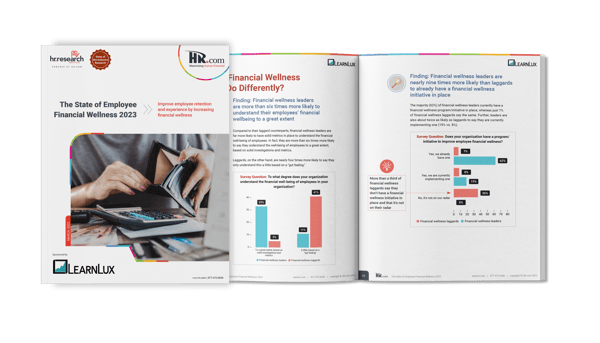Financial stress is a leading cause of concern for employees, affecting their overall wellbeing and productivity. By understanding the sources of financial stress in the workplace, organizations can provide targeted initiatives that drive real results.
In the new HR.com and LearnLux State of Employee Wellness report, experts provide insights into different methods to determine the sources of financial stress, ways to offer financial wellness initiatives that suit the needs of employees, and ways to track the success of these initiatives.
What are the key takeaways from the HR.com and LearnLux report? Read on for an overview of top insights for benefits professionals today.
Discover employees’ biggest sources of financial stress
By determining where employees are struggling, organizations can offer initiatives best suited to them. For example, if employees’ most common financial stressor deals with more immediate short-term concerns, implementing a financial initiative dealing only with retirement saving goals might not resonate.
Of course, data should typically be anonymous or anonymized to protect employee privacy. There are multiple ways to discern sources of financial stress, though each should be used carefully and wisely:
- Employee surveys that include questions about financial pressures
- Focus groups or one-on-ones to help employers understand issues in greater detail
- Absenteeism rates
- Productivity rates
- Healthcare costs
- Usage rates of any financial programs
- Aggregate data from employee assistance programs
Offer financial wellness initiatives that best suit the needs of your organization and employees
Financial wellness initiatives may not only help current employees in multiple ways, they could also aid with recruiting new employees. However, employers don’t need to do everything at once. They can pick and choose the initiatives that best meet the needs of employees.
There is a wide array of possible initiatives from which to choose, such as:
- Financial education or counseling
- One-on-one financial coaching
- Help with costs related to medical or mental health bills
- Help with savings planning
- Retail discounts
- Low-cost loans
- Personalized financial wellness plans
- Earned wage access
- Debt-relief benefits
Track a variety of metrics to determine the success of financial wellness initiatives
Once financial wellness initiatives are implemented, it’s important to find out if:
- These initiatives are actually helping employees
- What the impact is on the organization
Consider metrics such as enrollment and contribution numbers, job satisfaction, employee turnover trends, and how employees feel about the financial wellness programs.
Our data finds that financial wellness leaders are more likely to track the success of financial wellness initiatives with a variety of metrics. Tracking success through multiple data points can paint a bigger picture. If an initiative is lackluster, use these metrics to discover why this is the case and what can be done to improve.
Consider offering financial wellness education
Virtually all of our respondents say that financial education is important, though fewer than half actually offer such education initiatives. Consider offering financial education initiatives that will cover multiple areas regarding financial wellness so employees can choose the ones most relevant and interesting to them.
For example, consider offering education on budget planning, retirement goals, or student loans so employees in different life stages can get something out of these initiatives.
Ensure employees are comfortable reaching out in regard to financial issues
By cultivating an organizational culture that is open and honest, employees may be more comfortable seeking help. However, not every employee will be comfortable in every circumstance.
For example, if your organization brings in an expert guest speaker, ensure employees have a judgment-free and confidential opportunity to ask questions or seek advice in a non-public setting. Consider also implementing an anonymous help initiative so employees can seek help or advice without having to disclose their personal details.
Work toward closing pay gaps
Inflation and rising costs have affected many employees. HR professionals say not earning enough money to pay bills or debt is one of the top sources of financial stress for their employees.
Further, underrepresented employees, such as women of color, are more likely to make less than their white male counterparts. Consider conducting a pay equity audit to ensure inequitable pay gaps are closed.
Make it easier for employees to save money
An organization can set up defaults so that employees enroll in retirement saving plans automatically, even while still giving them the power to opt out of those plans. Behavioral scientist Katy Milkman, a professor at The Wharton School of the University of Pennsylvania, notes, “[Defaults are] a really powerful tool that a policymaker or employer, a benevolent government can use to try to help make it easier for citizens, or again, employees to end up with the best possible outcome because something has to be a default in most situations. So, once you recognize their importance, you can try to be careful and thoughtful and choose defaults that will lead to good outcomes. There are many ways employees can set up defaults, including default savings contributions with each paycheck to have an automatic withdrawal that's sent straight to a savings account so that money just disappears and goes right where you want it to go forever after.”
---
About LearnLux: LearnLux is the leading workplace financial well-being provider that blends fiduciary digital planning with access to one-on-one guidance from Certified Financial Planner™️ professionals. LearnLux's award-winning program equips employees with a financial plan to guide them through decision points like budgeting, paying down debt, electing benefits, understanding equity compensation, starting a family, buying a home, saving for retirement, and more. Advanced reporting keeps our partners in the know, and drives results like reduction in financial stress, increased productivity, reduced employee turnover, greater use of pretax products, on-time retirement, and healthcare savings. LearnLux members feel great about their money, allowing their work and well-being to thrive.
About HR.com and the HR Research Institute: The HR Research Institute helps you keep your finger on the pulse of HR! Powered by HR.com, the world’s largest community of Human Resources professionals, the HR Research Institute benchmarks best practices and tracks trends in human resources to help more than 2 million HR professionals (that many people can’t be wrong!). Companies are backing up their strategic decisions with informed and insightful HR.com research references! Over the past few years, the HR Research Institute has produced more than 180 exclusive primary research and state of the industry research reports, along with corresponding infographics, based on surveys of thousands of HR professionals. Each research report highlights current HR trends, benchmarks, and industry best practices.


